Instructor: Dr. Natalia Tretyakova, Ph.D.
«hyperlink
"mailto:Trety001@umn.edu"»
- 6-3432
PDB reference correction and design Dr.chem.,
Ph.D. Aris
Kaksis, Associate Prof. mailto:ariska@latnet.lv
5' 3'
DNA
SynthesisDNA
Synthesis

3'
5'
3'
5'
Primer
Synthesis and removal
3'  5'
5'
|| Primase
3'  5'
5'
5'  3'
3'
RNA primer
 + || DNA Pol
III
+ || DNA Pol
III
3'  5'
5'
5' 
 --> 3'
--> 3'
¯ DNA Pol I
DNA strand
3'
 5'
5'
5'  3'
3'
degraded 






 <- primer + || DNA
Ligase
<- primer + || DNA
Ligase
3'  5'
5'
5'  3'
3'
Replication Fork Garland
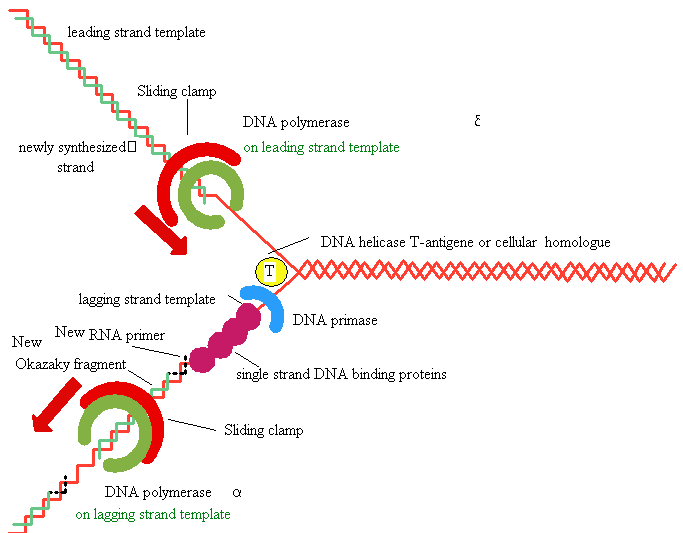

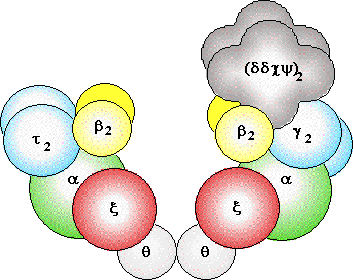
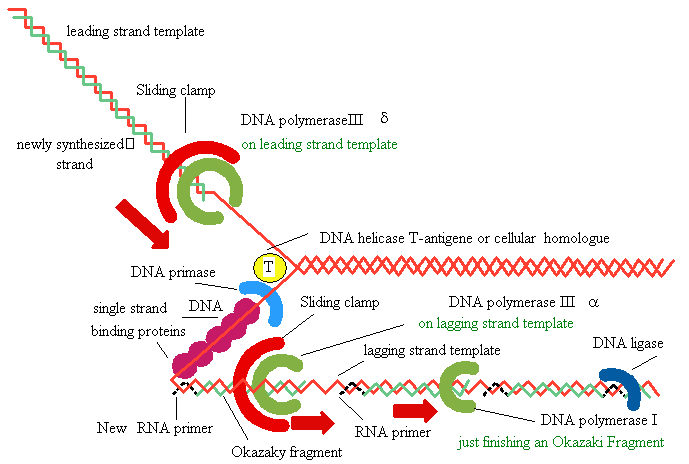
Antitumor
drug examples
Cyclophosphamide
Cytoxan®
Melphalan
Alkeran®
Busulfan
Myleran®
form crosslinks
Chlorambucil
Leukeran®
Mitomycin
Mutamycin®
Cisplatin
Platinol®
Bleomycin
Blenoxane®
cuts DNA strands between A= or G º
C
or G º
C
Dactinomycin
Cosmegen ® inserts
into the double helix preventing its unwinding
Chemical modification of DNA
Carcinogen (X) ---------------> detoxification --> excretion
metabolic activation || 
reactive
metabolite (X-) + DNA
 ||
DNA adducts
||
DNA adducts
 ||repair
||
|| replication
||repair
||
|| replication
intact DNA
cell death mutations

DNA
cross-linking agents as anti-tumor drugs
Nitrogen
mustards


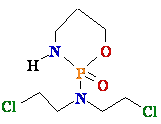
Mechlorethamine
Chlorambucil
Cyclo amide
amide
Mechanism:
 >
> ->
->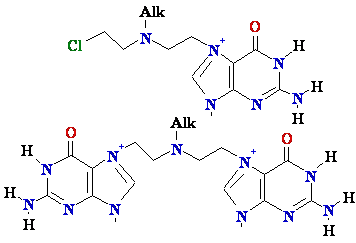
Interstrand cross-links block strand
separation
5' 3'
required for DNA
Synthesis

N7-alkylguanines
can be stabilized by 2 pathways
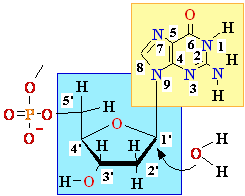 -->
-->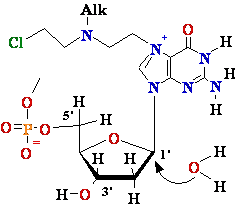 ||
||
Depurination |
|Ring
cleavage
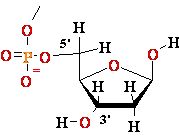 Abasic
site
Abasic
site 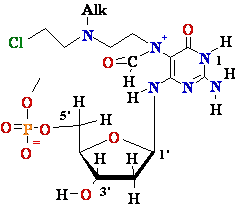
Importance
of DNA Repair
• DNA
is the only biological macromolecule that is repaired.
All others are
replaced.
• More than 100 genes are
required for DNA repair,
even
in organisms with very small genomes.
• Cancer
is a consequence of inadequate DNA
repair.
DNA
Repair Strategy
• Take
advantage of the double-stranded (double information) nature
of the DNA
molecule.
• Remove damaged nucleobase (nucleotide)
and fill the gap
using
the complementary strand as a template
DNA
Repair Types
¤ Base
excision repair
¤ Direct
repair
¤ Nucleotide
excision repair
¤ Mismatch
repair
¤ Recombination
repair
Base
excision repair
¤ Used for repair of small damaged
bases in DNA (AP sites, 8-oxo-G, _)
¤ Human gene hogg1 is often deleted in
lung cancer
¤ Several steps are involved:
a) modified base is
excised by N-glycosylase
b) the abasic site is cleaved with endonuclease
c) the resulting gap
is filled by Polymerase b?
d) DNA Ligase seals
the strands
Base excision repair mechanism
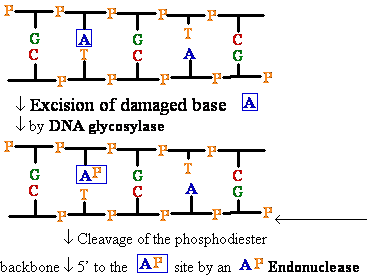


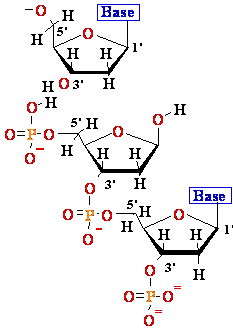
Direct repair
¤ ||
DNA photolyase -->
 -->
-->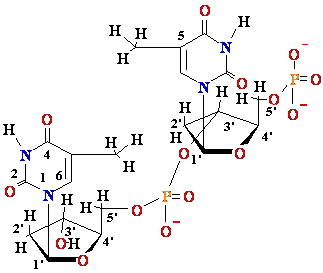
¤O6-alkyltransferase
O6-alkylguanine DNA
alkyltransferase
¤ Directly repaires alkylation
damage (O6-Me-dG, O6-POB-dG)
¤ stoichiometric reaction,
enzyme inactivated via alkylation of
Cys in the binding site
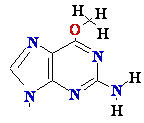 +
AGT-CH2-
+
AGT-CH2- -H -->
-H -->  +
AGT-CH2-
+
AGT-CH2- -CH3
-CH3
O6-methylguanine
© AGT enzyme is highly
conserved:
a) helix-turn-helix motif
b) hydrophobic side-chains form
alkyl-binding pocket
Nucleotide excision repair
(NER)
¨
Corrects any damage that both distorts the DNA
molecule and alters
the
chemistry of the DNA molecule
(pyrimidine dimers, benzo[a]pyrene-dG adducts, cisplatin-cross-links).
¨
Xeroderma pigmentosum is a genetic disorder resulting in defective NER
¨
Special excision nuclease (exinuclease)
hydrolyzes phosphodiester bond to release a short oligonucleotide fragment (about 12-20
nucleotides, 3-5th
3’ from the lesion and 7-12
nucleotides 5’ from the lesion)
4. Pol
d/e replaces the removed strand
5. DNA
ligase seals the ends
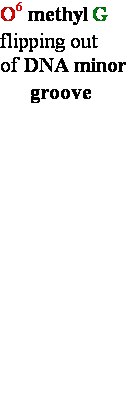
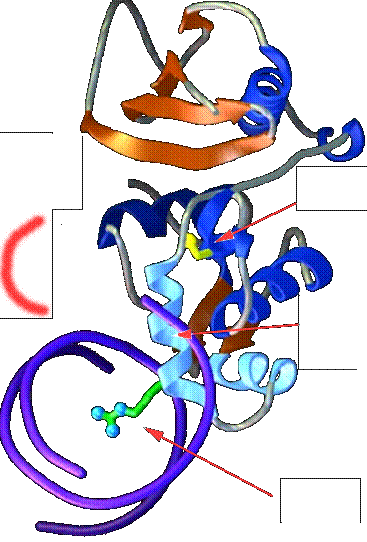
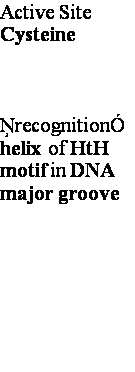
Arginine
Flipper
Nucleotide excision repair (NER)
 DNA with dimer
Mammalian
Enzyme
DNA with dimer
Mammalian
Enzyme
 Dimer reconized and DNA cut exinuclease
Dimer reconized and DNA cut exinuclease
 Dimer
excised
Dimer
excised
 Gap filled by DNA polymerase Pol d/e
Gap filled by DNA polymerase Pol d/e
 Nick sealed by DNA ligase DNA
ligase
Nick sealed by DNA ligase DNA
ligase
Recombination repair


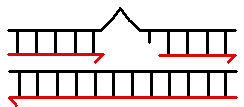




Genetic diseases associated
with defective DNA repair
Xeroderma
Pigmentosum
NER
Hereditary
nonpolyposis colorectal cancer
MMR
Cockrayne’s
syndrome
NER
Falconi’s
anemia
DNA
ligase
Bloom’s
syndrome
BER,
ligase
Lung cancer
(?)
BER
Predict repair mechanisms
for the following types of DNA damage
 site
DNA
Synthesis: Take Home Message
site
DNA
Synthesis: Take Home Message

double strand
break
1) DNA synthesis
is carried out by DNA polymerases
 glycol with high fidelity.
glycol with high fidelity.
UV photo
products
2) DNA
synthesis is characterized by initiation,
 :G
mismatch priming
and
processive synthesis steps and
:G
mismatch priming
and
processive synthesis steps and
polyclic
aromatic
proceeds in 5’ ® 3’ direction.
| hydrocarbon
adducts 3)
Modifications of DNA base pairs, if
not repaired,
exocyclic
adducts (propano) can
lead to mutations of the
N7-methylguanine
DNA
sequence.
O6- ethylguanine









 >
> ->
->

 -->
--> ||
||
 Abasic
site
Abasic
site 




 -->
-->
 +
AGT-CH2-
+
AGT-CH2- +
AGT-CH2-
+
AGT-CH2-


 DNA with dimer
Mammalian
Enzyme
DNA with dimer
Mammalian
Enzyme  Dimer reconized and DNA cut exinuclease
Dimer reconized and DNA cut exinuclease 





